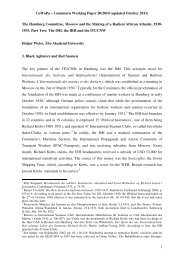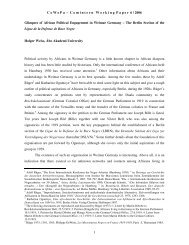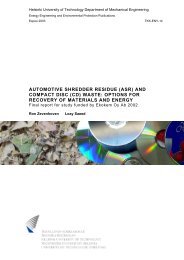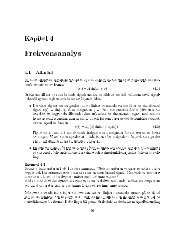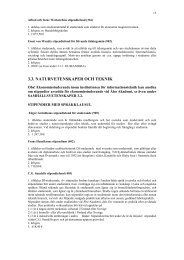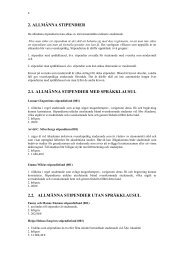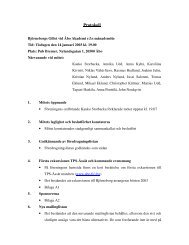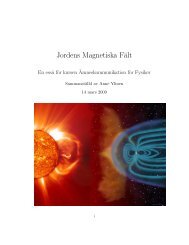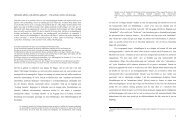biotic couplings on shallow water soft bottoms-examples from the ...
biotic couplings on shallow water soft bottoms-examples from the ...
biotic couplings on shallow water soft bottoms-examples from the ...
Create successful ePaper yourself
Turn your PDF publications into a flip-book with our unique Google optimized e-Paper software.
164 ERIK BONSDORFF AND EA MARIA BLOMQVIST<br />
TABLE I11<br />
Fish species utilising <strong>the</strong> <strong>shallow</strong> <strong>water</strong> (0-5 m) archipelago areas of <strong>the</strong> nor<strong>the</strong>rn<br />
Baltic Sea, <strong>the</strong>ir ecological origin (fresh<strong>water</strong> = F, and marine = M), mode of<br />
feeding (predatory = Pr, planktivorous = P1, omnivorous = Om), and regi<strong>on</strong> of<br />
main occurrence (inner archipelago = I, middle archipelago = M, and outer<br />
archipelago = 0). Note that most fish species utilising <strong>the</strong> <strong>shallow</strong> <strong>water</strong>s also<br />
c<strong>on</strong>sume benthos, and thus participate in <strong>the</strong> benthic interacti<strong>on</strong>s of <strong>the</strong>se habitats<br />
(Blomqvist, 1982, 1984, 1986; Mattila & B<strong>on</strong>sdorff, 1988; B<strong>on</strong>sdorff & Blomqvist,<br />
1989; Rask, 1989; B<strong>on</strong>sdorff et al., 1990; Koli, 1990; Wistbacka, 1992).<br />
Species Origin Feeding type Occurrence<br />
-<br />
Pike (Esox lucius) F<br />
Whitefish (Coreg<strong>on</strong>us lavaretus) S. L. F<br />
Perch (Perca juviatilis) F<br />
Pikeperch (Stizostedi<strong>on</strong> lucioperca) F<br />
Ruffe (Gymnocephalus cernua) F<br />
Ide (Leuciscus idus) F<br />
Roach (Rurilus rurilus) F<br />
Rudd (Scardinius erythrophrhalmus) F<br />
White bream (Blicca bjoerkna) F<br />
Bream (Abramis brama) F<br />
Crucian carp (Carassius carassius) F<br />
Bleak (Albumus alburnus) F<br />
Cod (Gadus morhua) M<br />
Burbot (Lota lora) F<br />
Minnow (Phoxinus phoxinus) F<br />
Baltic herring (Clupea harengus membras) M<br />
Sprat (Sprartus spratrus) M<br />
Three-spined stickleback (Gasterosreus aculeatus) FIM<br />
Nine-spined stickleback (Pungitius pungitius) F<br />
Fifteen-spined stickleback (Spinachia spinachia) M<br />
Comm<strong>on</strong> goby (Pomatoschistus microps) M<br />
Sand goby (P. minutus) M<br />
Two-spotted goby (Gobiusculus flavescens) M<br />
Black goby (Gobius niger) M<br />
Eelpout (Zoarces viviparus) M<br />
Bullhead (C<strong>on</strong>us gobio) F<br />
Four-horned sculpin (Myoxocephalus quadricornis) M<br />
Sea scorpi<strong>on</strong> (Ceratocottus bubalis) F<br />
Flounder (Platicthys Jesus) M<br />
Turbot (Pserta maxima) M<br />
Deep-snouted pipefish (Syngnathus typhle) M<br />
Straight-nosed pipefish (Nerophis ophidi<strong>on</strong>) M<br />
Pr (fish)<br />
Pr (plankt<strong>on</strong>, benthos)<br />
Pr (benthos, fish)<br />
Pr (fish)<br />
Pr (benthos)<br />
Pr (benthos)<br />
Om<br />
Om<br />
Om<br />
Om<br />
Om<br />
PI<br />
Pr (benthos, fish)<br />
Pr (fish, benthos)<br />
Pr (benthos)<br />
PI<br />
PI<br />
PR (benthos, plankt<strong>on</strong>)<br />
Pr (benthos, plankt<strong>on</strong>)<br />
Pr (benthos, plankt<strong>on</strong>)<br />
Pr (benthos)<br />
Pr (benthos)<br />
Pr (benthos, plankt<strong>on</strong>)<br />
Pr (benthos)<br />
Pr (benthos)<br />
Pr (benthos, roe)<br />
Pr (benthos)<br />
Pr (benthos)<br />
Pr (benthos)<br />
Pr (benthos)<br />
PI<br />
PI<br />
1-0<br />
M-0<br />
1-0<br />
I+M<br />
I-tM<br />
I+M<br />
1-0<br />
I+M<br />
I-M<br />
I -- M<br />
I<br />
1-0<br />
0<br />
I (-' 0)<br />
M-0<br />
M+O<br />
0<br />
M--0<br />
1-0<br />
M--0<br />
I--M(0)<br />
(I) M - 0<br />
0<br />
1+0<br />
0<br />
M+O<br />
0<br />
0<br />
0<br />
0<br />
M+O<br />
M+O<br />
Mattila & B<strong>on</strong>sdorff, 1988; Nellbring, 1988; Aarnio & B<strong>on</strong>sdorff, 1992), and<br />
with changed size of <strong>the</strong> fish (Aarnio & B<strong>on</strong>sdorff, 1992; Mattila, 1992). Size<br />
selecti<strong>on</strong> within given prey populati<strong>on</strong>s (Le<strong>on</strong>ardss<strong>on</strong> et al., 1988) may ulti-<br />
mately participate in <strong>the</strong> structuring of <strong>the</strong> benthic community (B<strong>on</strong>sdorff et al.,<br />
1986b; Nellbring, 1988; Mattila, 1992). Many fish species are fur<strong>the</strong>rmore able<br />
to alter <strong>the</strong>ir feeding niche with changes in <strong>the</strong> envir<strong>on</strong>ment (for example vari-<br />
ati<strong>on</strong>s in <strong>water</strong> temperature, spatial heterogeneity etc.), or with altered com-<br />
petiti<strong>on</strong> for food (Magnhagen & Wiederholm, 1982; Bergman, 1987, 1988). If,<br />
<strong>on</strong> <strong>the</strong> o<strong>the</strong>r hand, <strong>the</strong> availability of food (i.e. <strong>the</strong> presence and abundance of<br />
zoobenthos) changes dramatically al<strong>on</strong>g a geographic gradient, this may regulate




